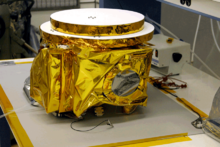
The W. M. Keck Observatory is an astronomical observatory with two telescopes at an elevation of 4,145 meters (13,600 ft) near the summit of Mauna Kea in the U.S. state of Hawaii. Both telescopes have 10 m (33 ft) aperture primary mirrors, and when completed in 1993 and 1996 were the largest optical reflecting telescopes in the world. They are currently the 3rd and 4th largest.

New Horizons is an interplanetary space probe launched as a part of NASA's New Frontiers program. Engineered by the Johns Hopkins University Applied Physics Laboratory (APL) and the Southwest Research Institute (SwRI), with a team led by Alan Stern, the spacecraft was launched in 2006 with the primary mission to perform a flyby study of the Pluto system in 2015, and a secondary mission to fly by and study one or more other Kuiper belt objects (KBOs) in the decade to follow, which became a mission to 486958 Arrokoth. It is the fifth space probe to achieve the escape velocity needed to leave the Solar System.
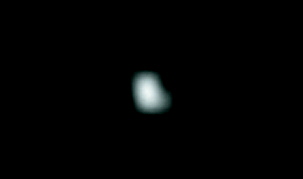
132524 APL, provisional designation 2002 JF56, is a small background asteroid in the intermediate asteroid belt. It was discovered by Lincoln Near-Earth Asteroid Research in May 2002, and imaged by the New Horizons space probe on its flyby in June 2006, when it was passing through the asteroid belt. The stony S-type asteroid measures approximately 2.5 kilometers (1.6 miles) in diameter.

An imaging spectrometer is an instrument used in hyperspectral imaging and imaging spectroscopy to acquire a spectrally-resolved image of an object or scene, often referred to as a datacube due to the three-dimensional representation of the data. Two axes of the image correspond to vertical and horizontal distance and the third to wavelength. The principle of operation is the same as that of the simple spectrometer, but special care is taken to avoid optical aberrations for better image quality.

The Wide Field Camera 3 (WFC3) is the Hubble Space Telescope's last and most technologically advanced instrument to take images in the visible spectrum. It was installed as a replacement for the Wide Field and Planetary Camera 2 during the first spacewalk of Space Shuttle mission STS-125 on May 14, 2009.
JunoCam is the visible-light camera/telescope onboard NASA's Juno spacecraft currently orbiting Jupiter. The camera is operated by the JunoCam Digital Electronics Assembly (JDEA). Both the camera and JDEA were built by Malin Space Science Systems. JunoCam takes a swath of imaging as the spacecraft rotates; the camera is fixed to the spacecraft, so as it rotates, it gets one sweep of observation. It has a field of view of 58 degrees with four filters.

ADEOS I was an Earth observation satellite launched by NASDA in 1996. The mission's Japanese name, Midori means "green". The mission ended in July 1997 after the satellite sustained structural damage to the solar panel. Its successor, ADEOS II, was launched in 2002. Like the first mission, it ended after less than a year, also following solar panel malfunctions.

An astronomical filter is a telescope accessory consisting of an optical filter used by amateur astronomers to simply improve the details and contrast of celestial objects, either for viewing or for photography. Research astronomers, on the other hand, use various band-pass filters for photometry on telescopes, in order to obtain measurements which reveal objects' astrophysical properties, such as stellar classification and placement of a celestial body on its Wien curve.

Jovian Infrared Auroral Mapper (JIRAM) is an instrument on the Juno spacecraft in orbit of the planet Jupiter. It is an image spectrometer and was contributed by Italy. Similar instruments are on ESA Rosetta, Venus Express, and Cassini-Huygens missions. The primary goal of JIRAM is to probe the upper layers of Jupiter's atmosphere down to pressures of 5–7 bars at infrared wavelengths in the 2–5 μm interval using an imager and a spectrometer. The Jupiter's atmosphere and auroral regions are targeted for study. In particular it has been designed to study the dynamics and chemistry in the atmosphere, perhaps determining the how Jovian hot spots form.

Sentinel-5 Precursor (Sentinel-5P) is an Earth observation satellite developed by ESA as part of the Copernicus Programme to close the gap in continuity of observations between Envisat and Sentinel-5.
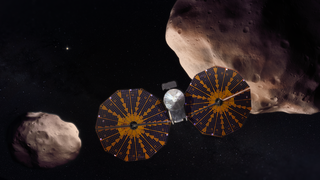
Lucy is a NASA space probe on a twelve-year journey to eight different asteroids. It is slated to visit two main belt asteroids as well as six Jupiter trojans – asteroids that share Jupiter's orbit around the Sun, orbiting either ahead of or behind the planet. All target encounters will be flyby encounters. The Lucy spacecraft is the centerpiece of a US$981 million mission. It was launched on 16 October 2021.

MIRI, or the Mid-Infrared Instrument, is an instrument on the James Webb Space Telescope. MIRI is a camera and a spectrograph that observes mid to long infrared radiation from 5 to 28 microns. It also has coronagraphs, especially for observing exoplanets. Whereas most of the other instruments on Webb can see from the start of near infrared, or even as short as orange visible light, MIRI can see longer wavelength light.
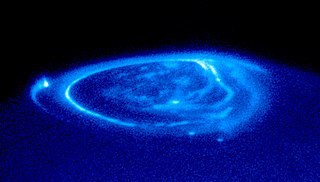
UVS, known as the Ultraviolet Spectrograph or Ultraviolet Imaging Spectrometer is the name of an instrument on the Juno orbiter for Jupiter. The instrument is an imaging spectrometer that observes the ultraviolet range of light wavelengths, which is shorter wavelengths than visible light but longer than X-rays. Specifically, it is focused on making remote observations of the aurora, detecting the emissions of gases such as hydrogen in the far-ultraviolet. UVS will observes light from as short a wavelength as 70 nm up to 200 nm, which is in the extreme and far ultraviolet range of light. The source of aurora emissions of Jupiter is one of the goals of the instrument. UVS is one of many instruments on Juno, but it is in particular designed to operate in conjunction with JADE, which observes high-energy particles. With both instruments operating together, both the UV emissions and high-energy particles at the same place and time can be synthesized. This supports the Goal of determining the source of the Jovian magnetic field. There has been a problem understanding the Jovian aurora, ever since Chandra determined X-rays were coming not from, as it was thought Io's orbit but from the polar regions. Every 45 minutes an X-ray hot-spot pulsates, corroborated by a similar previous detection in radio emissions by Galileo and Cassini spacecraft. One theory is that its related to the solar wind. The mystery is not that there are X-rays coming Jupiter, which has been known for decades, as detected by previous X-ray observatories, but rather why with the Chandra observation, that pulse was coming from the north polar region.
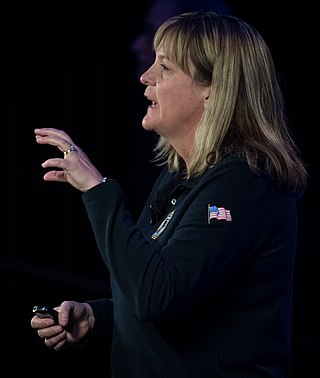
Cathy Olkin is a planetary scientist at the Southwest Research Institute, focusing on the outer Solar System. She is deputy principal investigator for NASA's Lucy mission examining the Trojan asteroids around Jupiter, which launched in 2021 and will fly past its targets between 2025 and 2033.
Lisa Hardaway (1966–2017) was an American aerospace engineer and program manager for an instrument on the New Horizons spacecraft to Pluto and Beyond. Among her awards, she was named Engineer of the Year for 2015–2016 by the Colorado American Institute of Aeronautics and Astronautics.
Nadir and Occultation for MArs Discovery (NOMAD) is a 3-channel spectrometer on board the ExoMars Trace Gas Orbiter (TGO) launched to Mars orbit on 14 March 2016.

Long Range Reconnaissance Imager (LORRI) is a telescope aboard the New Horizons spacecraft for imaging. LORRI has been used to image Jupiter, its moons, Pluto and its moons, and Arrokoth since its launch in 2006. LORRI is a reflecting telescope of Ritchey-Chrétien design, and it has a main mirror diameter of 208 mm across. LORRI has a narrow field of view, less than a third of a degree. Images are taken with a CCD capturing data with 1024 × 1024 pixels. LORRI is a telescopic panchromatic camera integrated with the New Horizons spacecraft, and it is one of seven major science instruments on the probe. LORRI does not have any moving parts and is pointed by moving the entire New Horizons spacecraft.

Pluto Energetic Particle Spectrometer Science Investigation (PEPSSI), is an instrument on the New Horizons space probe to Pluto and beyond, it is designed to measure ions and electrons. Specifically, it is focused on measuring ions escaping from the atmosphere of Pluto during the 2015 flyby. It is one of seven major scientific instruments aboard the spacecraft. The spacecraft was launched in 2006, flew by Jupiter the following year, and went onto flyby Pluto in 2015 where PEPSSI was able to record and transmit back to Earth its planned data collections.

Alice is an ultraviolet imaging spectrometer, with one used on the New Horizons spacecraft, and another on the Rosetta spacecraft. Alice is a small telescope with a spectrograph and a special detector with 32 pixels each with 1024 spectral channels detecting ultraviolet light. The instrument has a mass of 4.4 kg and draws 4.4 watts of power. Its primary role is to determine the relative concentrations of various elements and isotopes in Pluto's atmosphere.


